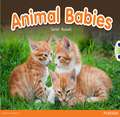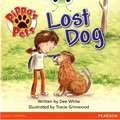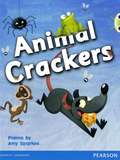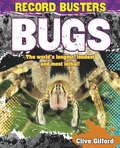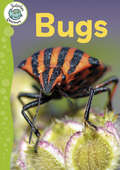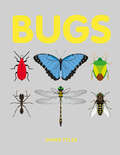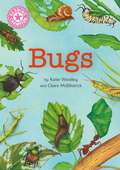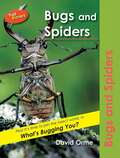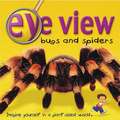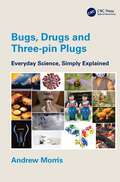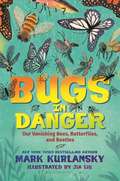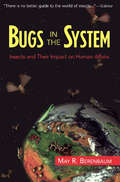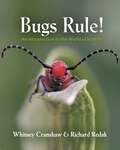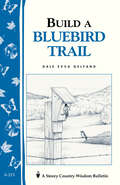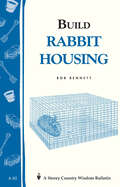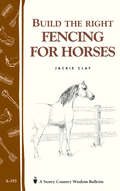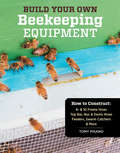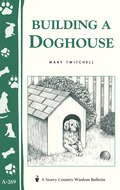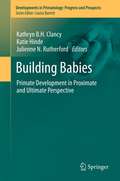- Table View
- List View
Buffalo Footprint (UEB uncontracted)
by RnibThis is an image of a buffalo footprint. The image has been repeated on the page so that it can be cut vertically in the centre to give two copies. There is a locator dot shown, which will be at the top left of the page when the image is the correct way up. The front of the footprint is at the top of the image. An adult buffalo footprint can measure up to 12 centimetres (4.7 inches).
Bug Club, Orange, B: King Julien's Jobs (PDF)
by Cas LesterThis title is part of Pearson's Bug Club - the first whole-school reading programme that joins books and an online reading world to teach today's children to read. In this book, King Julien has a lot of jobs to do but he doesn't want to do them! His friend, Timo, makes him a special drink. Will it help King Julien finish his jobs?
Bug Club, Red B: Animal Babies (PDF)
by Sarah RussellThis title is part of Pearson's Bug Club - the first whole-school reading programme that joins books and an online reading world to teach today's children to read. In this Red B (KS1) Animal Babies book: These animals all have babies. What are the baby animals called?
Bug Club, Turquoise, A: King Julien and the Rain Dance (PDF)
by Cas LesterThis title is part of Pearson's Bug Club - the first whole-school reading programme that joins books and an online reading world to teach today's children to read. In this book, It hasn't rained for ages. King Julien is supposed to do a rain dance but there is a small problem ... he has forgotten the steps!
Bug Club, Yellow A, Pippa's Pets: Lost Dog (PDF)
by Dee WhitePippa finds a lost dog. What will Pippa do?
Bug Club Yellow Animal Crackers (PDF)
by Amy SparkesThis title is part of Pearson's Bug Club - the first whole-school reading programme that joins books and an online reading world to teach today's children to read. In this Yellow Animal Crackers Poems book: Have you ever seen a shark who is afraid of the dark, or a kangaroo who loves lollipops? Join in the fun and meet some animals who are just crackers!
Bugs: Bugs (Record Busters #7)
by Clive GiffordPerfect for capturing a young general reader's or an older reluctant reader's interest, this hi-lo title features gripping, minimal, fact-based text, dramatic and impactful pictures, and an edgy design to reveal the longest, loudest and most deadly bugs!
Bugs (Tadpoles Learners #6)
by Annabelle LynchFind out all about funny bugs, from spotty ladybirds to darting dragonflies. Tadpoles Learners are an ideal introduction to non-fiction for beginner readers, blending accessible text with big, striking photos.
Bugs
by Simon TylerPacked with stunning, detailed illustrations and astonishing facts, this book will introduce you to some of the strangest, scariest, biggest, smallest and most beautiful insects around.
Bugs: Independent Reading Non-Fiction Pink 1a (Reading Champion #515)
by Katie WoolleyThis book is part of Reading Champion, a series carefully linked to book bands to encourage independent reading skills, developed with UCL Institute of Education (IOE)Bugs is a non-fiction text exploring how different bugs eat leaves. The repeated sentence structure offers readers the opportunity for a very first independent reading experience with the support of the illustrations.Reading Champion offers independent reading books for children to practise and reinforce their developing reading skills.This non-fiction text is accompanied by engaging artwork and a reading activity. Each book has been carefully graded so that it can be matched to a child's reading ability, encouraging reading for pleasure.
Bugs and Spiders (Trailblazers Ser.)
by David OrmeWhich bug has the most legs? Which bug is the fastest runner? Which spider is the most poisonous? And what's the deadliest bug of all? You might be surprised! This is the world of bugs and spiders. Find out all about it. Get the facts. Got that? Then read 'What's Bugging You?', a story about alien explorers who get a BIG welcome from the local insect life.
Bugs and Spiders: Eye View (PDF)
by Barbara TaylorEach book in this series, aimed at 3-6 year olds, lets them get close to amazing creatures! Short, simple text offers bite-sized chunks of information that is accompanied by close-up photography and magnified images that give an exclusive perspective on subjects. This book focuses on bugs and spiders.
Bugs, Drugs and Three-pin Plugs: Everyday Science, Simply Explained
by Andrew MorrisFor the millions who remain curious about the world around them, but gained little from science at school, this book offers a way forward. Based on live discussions with adults from all walks of life, each chapter begins with an everyday experience, like swallowing a pill or watching a bee on a flower. The main scientific ideas underlying each topic are then explored, so that understanding of a set of fundamental concepts builds up gradually throughout the book. In contrast to more traditional approaches to science learning, topics range freely across the subject areas. The story of Covid, for example includes aspects of biology, chemistry, mathematics and social behaviour. Plain English is used throughout and mathematical expressions are avoided. Key points are illustrated with clear diagrams and photographs. By drawing on questions and perspectives of ordinary people, the book offers an introduction to basic ideas in science as a whole, rather than any one particular subject. For the adult wishing to make good a gap in their understanding it provides a starting point for entering the rich world of popular science.
Bugs, Drugs and Three-pin Plugs: Everyday Science, Simply Explained
by Andrew MorrisFor the millions who remain curious about the world around them, but gained little from science at school, this book offers a way forward. Based on live discussions with adults from all walks of life, each chapter begins with an everyday experience, like swallowing a pill or watching a bee on a flower. The main scientific ideas underlying each topic are then explored, so that understanding of a set of fundamental concepts builds up gradually throughout the book. In contrast to more traditional approaches to science learning, topics range freely across the subject areas. The story of Covid, for example includes aspects of biology, chemistry, mathematics and social behaviour. Plain English is used throughout and mathematical expressions are avoided. Key points are illustrated with clear diagrams and photographs. By drawing on questions and perspectives of ordinary people, the book offers an introduction to basic ideas in science as a whole, rather than any one particular subject. For the adult wishing to make good a gap in their understanding it provides a starting point for entering the rich world of popular science.
Bugs in Danger: Our Vanishing Bees, Butterflies, and Beetles
by Mark KurlanskyBy now you've probably heard that bees are disappearing--but they aren't the only species at risk. Populations of fireflies, butterflies, and ladybugs have all been declining in recent years, too. This middle grade nonfiction explains the growth, spread, and recent declines of each of these four types of insects. Exploring human causes, like the Baltimore electric company that collected fireflies to attempt to harness their phosphorescent lighting source, to natural occurrences, like the mysterious colony collapse disorder that plagues bee populations, master nonfiction storyteller Mark Kurlansky shows just how much bugs matter to our world.
Bugs In The System: Insects And Their Impact On Human Affairs
by May R. BerenbaumAn introduction to insect physiology, genetics and behaviour which looks at the interaction between humans and insects, and explores both the positive and negative aspects of the relationship.
Bugs Rule!: An Introduction to the World of Insects
by Whitney Cranshaw Richard RedakBugs Rule! provides a lively introduction to the biology and natural history of insects and their noninsect cousins, such as spiders, scorpions, and centipedes. This richly illustrated textbook features more than 830 color photos, a concise overview of the basics of entomology, and numerous sidebars that highlight and explain key points. Detailed chapters cover each of the major insect groups, describing their physiology, behaviors, feeding habits, reproduction, human interactions, and more. Ideal for nonscience majors and anyone seeking to learn more about insects and their arthropod relatives, Bugs Rule! offers a one-of-a-kind gateway into the world of these amazing creatures. Places a greater emphasis on natural history than standard textbooks on the subject Covers the biology and natural history of all the insect orders Provides a thorough review of the noninsect arthropods, such as spiders, scorpions, centipedes, millipedes, and crustaceans Features more than 830 color photos Highlights the importance of insects and other arthropods, including their impact on human society An online illustration package is available to professors
Bugs Rule!: An Introduction to the World of Insects
by Whitney Cranshaw Richard RedakBugs Rule! provides a lively introduction to the biology and natural history of insects and their noninsect cousins, such as spiders, scorpions, and centipedes. This richly illustrated textbook features more than 830 color photos, a concise overview of the basics of entomology, and numerous sidebars that highlight and explain key points. Detailed chapters cover each of the major insect groups, describing their physiology, behaviors, feeding habits, reproduction, human interactions, and more. Ideal for nonscience majors and anyone seeking to learn more about insects and their arthropod relatives, Bugs Rule! offers a one-of-a-kind gateway into the world of these amazing creatures. Places a greater emphasis on natural history than standard textbooks on the subject Covers the biology and natural history of all the insect orders Provides a thorough review of the noninsect arthropods, such as spiders, scorpions, centipedes, millipedes, and crustaceans Features more than 830 color photos Highlights the importance of insects and other arthropods, including their impact on human society An online illustration package is available to professors
Build a Bluebird Trail: Storey's Country Wisdom Bulletin A-213 (Storey Country Wisdom Bulletin)
by Dale Evva GelfandConservationists across North America are working to help protect and support bluebirds, and you can do your part by creating a bluebird trail. This is simply a series of nesting boxes (anywhere from a few to a few thousand) set about 300 feet apart along a prescribed route. Dale Gelfand tells you what you need to know about bluebirds and their habits, and she shows you how to create and monitor an effective bluebird trail with well-designed nesting boxes.
Build Rabbit Housing: Storey Country Wisdom Bulletin A-82 (Storey Country Wisdom Bulletin)
by Bob BennettSince 1973, Storey's Country Wisdom Bulletins have offered practical, hands-on instructions designed to help readers master dozens of country living skills quickly and easily. There are now more than 170 titles in this series, and their remarkable popularity reflects the common desire of country and city dwellers alike to cultivate personal independence in everyday life.
Build the Right Fencing for Horses: Storey's Country Wisdom Bulletin A-193 (Storey Country Wisdom Bulletin)
by Jackie ClaySince 1973, Storey's Country Wisdom Bulletins have offered practical, hands-on instructions designed to help readers master dozens of country living skills quickly and easily. There are now more than 170 titles in this series, and their remarkable popularity reflects the common desire of country and city dwellers alike to cultivate personal independence in everyday life.
Build Your Own Beekeeping Equipment: How to Construct 8- & 10-Frame Hives; Top Bar, Nuc & Demo Hives; Feeders, Swarm Catchers & More
by Tony PisanoTony Pisano provides step-by-step illustrated instructions showing you how to build hive bodies, supers, covers, stands, frames, swarm catchers, feeders, and more using basic hand tools and easy-to-find materials.
Building a Doghouse: (Storey's Country Wisdom Bulletins A-269) (Storey Country Wisdom Bulletin)
by Mary TwitchellBuild a Doghouse That's Just Right for Your Dog!While your dog may be a full-fledged member of the family, there are times when you must put him or her outdoors. Some dogs, for example, become over enthusiastically friendly when visitors appear, even to the point of knocking down your unsuspecting guests. Other dogs enjoy having some time to themselves in the backyard. Whatever the reason that shepherds the dog out the door, a nearby doghouse within a fenced-in area provides a protected, private space for your dog and peace of mind for you. A proper doghouse is a canine retreat, a place where your dog can hide from the hot sun, the cold rain, the harsh wind, and the worries of the world. Mary Twitchell takes you through all the options for building or buying a comfortable and cozy shelter for your canine companion. Whether you want to modify a barrel, buy a molded plastic shelter, or build a wooden doghouse, you'll find all the information you need right here, from choosing the right site to proper building techniques to encouraging your dog to use the new doghouse.
Building Babies: Primate Development in Proximate and Ultimate Perspective (Developments in Primatology: Progress and Prospects #37)
by Kathryn B.H. Clancy, Katie Hinde and Julienne N. RutherfordThe ontogeny of each individual contributes to the physical, physiological, cognitive, neurobiological, and behavioral capacity to manage the complex social relationships and diverse foraging tasks that characterize the primate order. For these reasons Building Babies explores the dynamic multigenerational processes of primate development. The book is organized thematically along the developmental trajectory:conception, pregnancy, lactation, the mother-infant dyad, broader social relationships, and transitions to independence. In this volume, the authors showcase the myriad approaches to understanding primate developmental trajectories from both proximate and ultimate perspectives. These collected chapters provide insights from experimental manipulations in captive settings to long-term observations of wild-living populations and consider levels of analysis from molecule to organism to social group to taxon. Strepsirrhines, New World monkeys, Old World monkeys, apes, and humans are all well-represented. Contributions by anthropologists, microbiologists, psychologists, population geneticists, and other primate experts provide Building Babies a uniquely diverse voice. Building Babies features multi- and trans-disciplinary research approaches to primate developmental trajectories and is particularly useful for researchers and instructors in anthropology, animal behavior, psychology, and evolutionary biology. This book also serves as a supplement to upper-level undergraduate courses or graduate seminars on primate life history and development. In these contexts, the book provides exposure to a wide range of methodological and theoretical perspectives on developmental trajectories and models how researchers might productively integrate such approaches into their own work.


